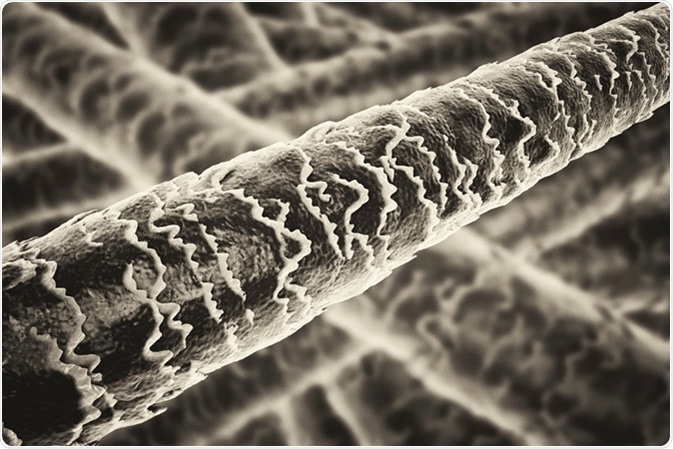Skip to
Hair samples are one of the most important resources in the forensic analysis of crime scenes, often providing valuable information that can help to lead to the identification of a suspect or victim.
Hairs are slender fibrous outgrowths projecting from the skin that possess different microscopic characteristics such as shape, color, and root appearance. Variability in such features can help forensic scientists to determine age, gender, and racial origin of the person that shed the hair, as well as allowing one to determine which area of the body hair has come from. Hair can also be used to extract DNA for analyses that can help to narrow down who may have been involved in a crime.

Human hair under microscope illustration. Image Credit: Kateryna Kon / Shutterstock
Hair Evidence
Humans shed an average of approximately 100 head hairs per day, and because hair can be easily transferred during physical contact it is commonly submitted as forensic evidence to help establish associations between people (e.g. a victim and suspect) and/or people and a crime scene.
Such associative evidence is especially useful in violent crimes where physical contact is likely to have occurred such as sexual assault, homicide, and aggravated assault. Crimes less likely to have involved physical contact such as armed robbery would typically involve collecting clothing or other items that may have picked up hair that could be used to identify suspects.
Examination of hair by microscopy can help to establish whether a hair was forcibly removed, diseased or treated with an artificial substance such as a hair dye. Forensic analysts use an instrument called a comparison microscope to view a known hair sample and an unknown sample alongside one another to see if they share similar characteristics and could have come from the same source.
Hair Comparison Microscopy
A comparison microscope, which is made up of two compound light microscopes connected by an optical bridge, allows the user to view a known and unknown hair sample simultaneously. The multi-phase examination process starts with the analyst establishing whether the unknown hair is of animal or human origin.
If it is an animal hair, the examiner can further identify it as belonging to a particular species, although it cannot be linked to a particular animal at the exclusion of other animals within the same species. Animal hairs found on items of evidence can link a suspect to a crime scene or a vehicle or location where a victim was held. Hairs from a pet the suspect owns, for example, may also be transferred to the victim when a suspect makes physical contact.
If the hair is human in origin, analysis can help to distinguish between individuals based on the arrangement, appearance and distribution of certain characteristics within different regions of the hair.
Factors to Consider
Many factors affect the robustness of hair association analyses, including variations in the adequacy of equipment and staff experience and training.
Although hair microscopy is a valuable tool to use for identification purposes, accurately determining a statistical probability of a given association is challenging, partly due to the lack of reliable quantitative assessment of hair characteristics.
However, the analysis can allow one of the following conclusions to be drawn:
- Whether the unknown hair exhibits similar characteristics to the known hair and could therefore have originated from the same source as the known hair
- Whether the unknown hair is dissimilar to the known hair and could not have originated from the same source
- Whether both similarities and dissimilarities were seen between the two hairs, meaning no decision about possible source of origin can be made
When forensic experts do find shared characteristics between the known and unknown hair, a statement such as the following may be added to their report:
“Hair comparisons are not a basis for absolute personal identification. It should be noted, however, that because it is unusual to find hairs from two different individuals that exhibit the same microscopic characteristics, a microscopic association or match is the basis for a strong association.”
In 2009, the National Academy of Sciences released a report called “Strengthening Forensic Science in the United States: A Path Forward,” which stated that since the advancement of DNA analysis, microscopic hair analysis should be confined to establishing which hairs to test, and whether hairs share similar characteristics, but should not be considered a reliable tool for the identification of individuals suspects.
The Suitability of Hair for DNA Analysis
To test the suitability of a human hair sample for nuclear DNA analysis, hair microscopy is used to view the end of a hair and establish whether it contains a root. If so, the sample can be tested using a nuclear DNA testing procedure called Short Tandem Repeat (STR) analysis. A hair that has been shed without a root cannot be sent for this type of testing, but can still be subjected to mitochondrial DNA (mtDNA) testing of the hair shaft.
A combination of microscopic hair comparisons and DNA analysis can provide a complementary approach that offers superior information about hair origin, compared with that obtained using microscopic hair comparisons alone.
Under The Microscope: The FBI Hair Cases | Fault Lines
Further Reading